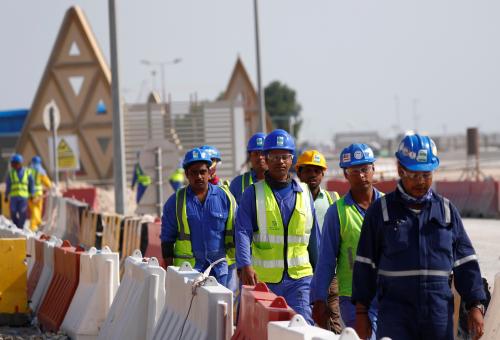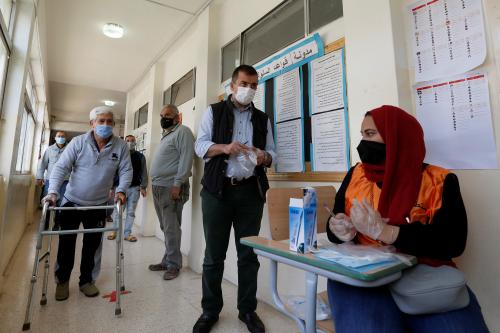Content from the Brookings Doha Center is now archived. In September 2021, after 14 years of impactful partnership, Brookings and the Brookings Doha Center announced that they were ending their affiliation. The Brookings Doha Center is now the Middle East Council on Global Affairs, a separate public policy institution based in Qatar.
We may very well be entering an Arab democratic moment. This is not about individual countries and their particular economic and political conditions, although those certainly matter. Something bigger is going on here. Arabs are discovering a power they weren’t aware they had. Arab regimes gave the impression of being stable, strong, and secure, backed by overwhelming coercive capacity. Facing such odds, fighting for democratic change seemed a losing battle.
Tunisia, then, was decisive. It showed that the long vaunted stability of authoritarian governments was illusory. They, too, could fall. All you needed was a good dose of people power. There is, after all, strength – and safety – in numbers.
Even if the attempted revolutions fail, Arab regimes can never go back to what they once were. They will live in fear of the next revolt. The opposition will wait in anticipation of the next revolt. The stability of any regime is no longer guaranteed. What is interesting this same feeling is replicated in widely divergent contexts. Inspired by Tunisia – and, now, Egypt – Yemeni activists are planning a “day of rage” for February 3. Syrians will be having theirs on February 5. Northern Sudan, too, has been roiled by protests. Meanwhile, the Jordanian opposition, after several years of treading water, has used a string of successful protests to push for unprecedented changes in the nature of Hashemite monarchy.
Two models of democratic change are emerging. One is the Tunisia-Egypt-Yemen model of overturning the regime. This would seem to apply in republics, where protesters have one simple, overarching demand – that the president give up power. The person of the president, because of his dominating, partisan role, provides a rallying point for protesters. This is conducive to opposition unity. They disagree on a lot, but last they can agree on the most important thing.
The other model of change focuses around constitutional reform in the Arab monarchies. In countries like Jordan and Morocco, there are reasonably free elections. But elections have limited relevance because it’s the king who has final decision-making authority. The problem here is not necessarily the king himself but the institution of the monarchy and its disproportionate power. The solution, then, is constitutional reform that shifts power away from the king toward an elected parliament and an independent judiciary. This is what opposition groups are calling for in Jordan.
While different, both models are about altering political structures rather than gradual, slow reform. Leaders have not caught on. They seem to still think they can offer half-measures to appease their people. But the lesson of Tunisia and Egypt – as well as Yemen, Jordan, and many others – is that Arab populations, after waiting and waiting, have run out of patience.



Commentary
Op-edIn the Middle East: Two Models for Democratic Change
February 2, 2011